
Meridian is the eighth most populous city in the U.S. state of Mississippi, with a population of 35,052 at the 2020 census. It is the county seat of Lauderdale County and the principal city of the Meridian, Mississippi Micropolitan Statistical Area. Along major highways, the city is 93 mi (150 km) east of Jackson; 154 mi (248 km) southwest of Birmingham, Alabama; 202 mi (325 km) northeast of New Orleans, Louisiana; and 231 mi (372 km) southeast of Memphis, Tennessee.

The Central Business District (CBD) is a neighborhood of the city of New Orleans, Louisiana, United States.
S. H. Kress & Co. was the trading name of a chain of five and dime retail department stores in the United States established by Samuel Henry Kress. It operated from 1896 to 1981. In the first half of the 20th century, there were Kress stores with ornamented architecture in hundreds of cities and towns.

Downtown Phoenix is the central business district (CBD) of the City of Phoenix, Arizona, United States. It is in the heart of the Phoenix metropolitan area or Valley of the Sun. Phoenix, being the county seat of Maricopa County and the capital of Arizona, serves as the center of politics, justice and government on the local, state and federal levels. The area is a major center of employment for the region, with many financial, legal, and other national and international corporations housed in a variety of skyscrapers. Major arts and cultural institutions also call the area home. Downtown Phoenix is a center of major league sports activities, live concert events, and is an equally prominent center of banking and finance in Arizona. Regional headquarters for several major banks, including JP Morgan Chase, Wells Fargo, US Bank, Bank of America, Compass Bank and Midfirst Bank are all located within or close proximity to the area.
Uptown Memphis is a neighborhood located near downtown Memphis, Tennessee. In 1999, the Uptown Partnership renamed the historic North Memphis Greenlaw neighborhood "Uptown" in concert with a public-private revitalization effort that defined Uptown as one hundred city blocks east of the Wolf River and North of A.W. Willis Avenue. The historic Greenlaw section of this neighborhood consists of the thirty city blocks closest to the Wolf River.

Meridian Museum of Art is an art museum located at 628 25th Avenue, Meridian, Mississippi. The building was added to the National Register of Historic Places in 1979 and declared a Mississippi Landmark in 1985. The building originally served as the home of the First Presbyterian Church of Meridian until the city of Meridian bought the building in 1911 and turned it into a Carnegie Library in 1913. The city originally constructed two Carnegie libraries — one for whites and one for African-Americans; the building currently housing the Meridian Museum of Art served as the white library. In 1970, after the libraries integrated and moved to a new location, the vacant building at 628 25th Avenue was transformed into the Meridian Museum of Art and still operates today.
The City of Oklahoma City uses Special Zoning Districts as a tool to maintain the character of many neighborhood communities.
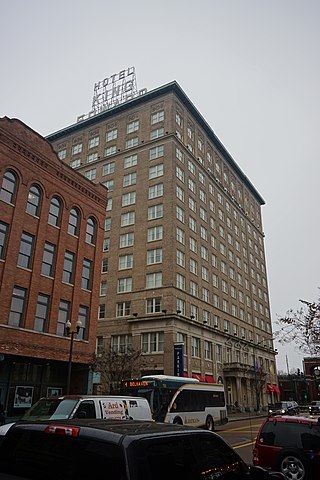
The King Edward Hotel, built in 1923 as the Edwards Hotel, is an historic hotel in downtown Jackson, Mississippi. The second of two buildings located on the site at the corner of Capitol and Mill Streets, it was closed and vacant for nearly 40 years before renovations began in 2006. The hotel was listed on the National Register of Historic Places in 1976, and declared a Mississippi Landmark in 1990. It was restored from 2007-2009 as a combination of apartments and the Hilton Garden Inn Jackson Downtown, which opened on December 17, 2009. It features the King Edward Grill, King Edward Bar, Pavilion Pantry convenience mart, a fitness center and formerly a Seattle's Best Coffee shop.
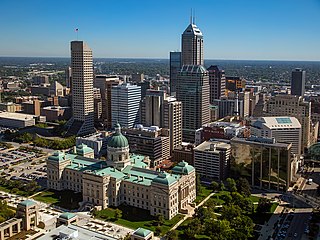
Downtown Indianapolis is a neighborhood area and the central business district of Indianapolis, Indiana, United States. Downtown is bordered by Interstate 65, Interstate 70, and the White River, and is situated near the geographic center of Marion County. Downtown has grown from the original 1821 town plat—often referred to as the Mile Square—to encompass a broader geographic area of central Indianapolis, containing several smaller historic neighborhoods.

Downtown San Diego is the city center of San Diego, California, the eighth largest city in the United States. In 2010, the area had a population of more than 28,000. Downtown San Diego serves as the cultural and financial center and central business district of San Diego, with more than 4,000 businesses and nine districts. The downtown area is the home of the San Diego Symphony and the San Diego Opera as well as multiple theaters and several museums. The San Diego Convention Center and Petco Park, home of the San Diego Padres, are also located downtown. Downtown San Diego houses the major local headquarters of the city, county, state, and federal governments.

Union Station, also called the Meridian Multi-Modal Transportation Center, is an intermodal transportation center in Meridian, Mississippi. The station is located at 1901 Front Street in the Union Station Historic District within the larger Meridian Downtown Historic District, both of which are listed on the National Register of Historic Places. Consisting of a new addition and renovated surviving wing of the 1906 building, Union Station was officially dedicated on December 11, 1997. It is a center of several modes of passenger transportation, including Amtrak train service on the Norfolk Southern rail corridor, Greyhound, and other providers of bus services.

Highland Park is a historic park in Meridian, Mississippi, United States. Home to a museum honoring Jimmie Rodgers, a Meridian native, the site was listed on the National Register of Historic Places in 1979. The park is also home to the Highland Park Dentzel Carousel and Shelter Building, a National Historic Landmark manufactured around 1896 by Gustav Dentzel of Philadelphia, Pennsylvania. The historic carousel is the only two-row stationary Dentzel menagerie still in existence.

The Threefoot Building is a historic office building located in downtown Meridian, Mississippi named after the Threefoot family who owned and operated a business in downtown Meridian during the late 19th century and early 20th century. Designed by Claude H. Lindsley and completed in 1929 in the Art Deco style, the 16-story building is still the tallest in the city. It was added to the National Register of Historic Places on December 18, 1979, under the Meridian Multiple Property Submission of buildings contributing to the historic nature of the city's downtown. In 2008 the Threefoot was recognized by the state as a Mississippi Landmark.
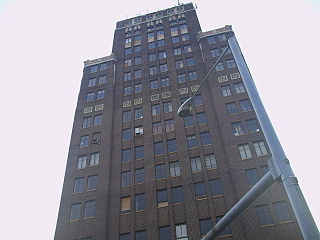
The history of Meridian, Mississippi begins in the early 19th century before European-American settlement. Originally settled by the Choctaw Indians, the land was bought by the United States according to the Treaty of Dancing Rabbit Creek in 1830. The city grew around the intersection of the Mobile and Ohio Railroad and the Southern Railway of Mississippi and developed a largely rail-based economy. Although much of the city was burned down in the Battle of Meridian during the American Civil War, the city was rebuilt and entered a "Golden Age." Between about 1890 and 1930, the city was the largest in Mississippi and a leading center for manufacturing in the Southern United States. After the decline of the railroading industry in the 1950s, the city's economy was devastated, resulting in a slow population decline. The population has continued to decline as the city has struggled to create a new, more modern economy based on newer industries. In the past 20 years or so, Meridian has attempted to revitalize the city's economy by attracting more business and industry to the city, most specifically the downtown area.

There are nine historic districts in Meridian, Mississippi. Each of these districts is listed on the National Register of Historic Places. One district, Meridian Downtown Historic District, is a combination of two older districts, Meridian Urban Center Historic District and Union Station Historic District. Many architectural styles are present in the districts, most from the late 19th century and early 20th century, including Queen Anne, Colonial Revival, Italianate, Art Deco, Late Victorian, and Bungalow.

Weidmann's Restaurant is a historic restaurant in Meridian, Mississippi, United States, established in 1870. It was originally listed as a contributing property to the Meridian Urban Center Historic District, listed on the National Register of Historic Places in 1979. The Urban Center Historic District was combined with the Meridian Depot Historic District in 2005 to become the Meridian Downtown Historic District.
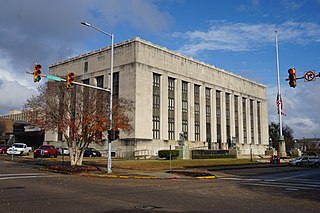
The United States Post Office and Courthouse in Meridian, Mississippi was built in 1933. It was listed on the National Register of Historic Places in 1984. It is a three-story limestone building built in a classical Art Deco style which was home to Meridian's main post office and a federal courthouse from its construction in 1933 until 2012 when the federal courthouse was closed due to budget cuts. The building itself is still open and still houses the post office.

Standard Drug Company is a historic pharmaceutical company in Meridian, Mississippi. Originally established as a small retail drug store in 1900, the company was incorporated in 1919 and became one of the largest commercial firms in the city. The building was listed on the National Register of Historic Places in 1989.
Claude H. Lindsley was an American architect based in Mississippi.
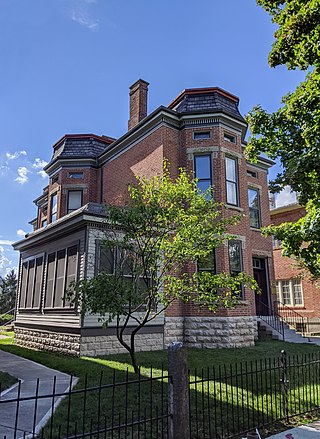
The Columbus Landmarks Foundation, known as Columbus Landmarks, is a nonprofit historic preservation organization in Columbus, Ohio. The foundation is best-known for its list of endangered sites in the city and its annual design award, given to buildings, landscapes, and other sites created or renovated in Columbus. It was established in 1977 as a project of the Junior League of Columbus, Ohio, following the demolition of the city's historic Union Station. It is headquartered at 57 Jefferson Avenue, a contributing structure in the Jefferson Avenue Historic District in Downtown Columbus.



























